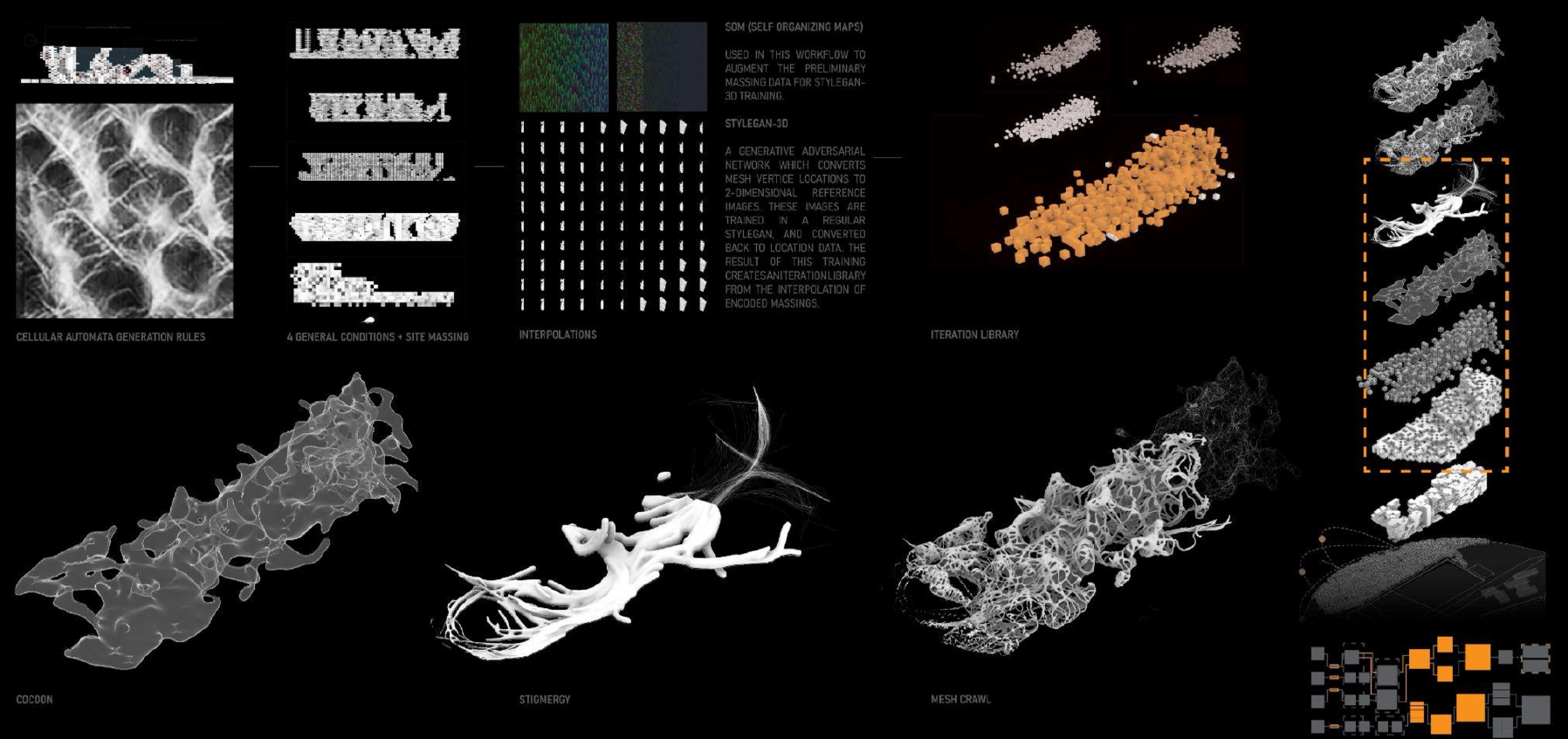Interconnectivity of Deep Learning Models in AI-Driven Design Systems
Abstract
The incorporation of deep learning models into architectural design poses challenges, despite their potential to inform new design processes. One of these issues is the oversimplification of the design problem when employing a discrete, single AI model to tackle a multifaceted, complex design activity. Importantly, the investigation of DL-driven systems requires the identification of components (parts) and relationships between these constituents of this new design workflow. The need to investigate a functional AI-driven design workflow structure with design intentions encoded and incorporated into a human-supervised process is an additional important issue identified by this research. How can specific levels of agency be identified and made explicit in the context of interacting with learning systems? This study investigates a novel human-AI collaborative workflow that combines machine and designer creativity within a comprehensive framework. The focus was on developing a design system, a "prototype" with interconnected AI and agent-based models (ABM) to address multiple architectural systems at various design levels (design tasks, design phases) while enacting the designer's varying degrees of agency. Curation of datasets, network types, and connection strategies are the design intentions when working with AI models. In developing a new design workflow, we employ systems theory and the need to deconstruct the design process into its component parts. Design is considered an "exploration activity" because it involves the modification and evolution of both the problem goals (design requirements) and the methods and means used to achieve the goals. The investigation centered on prototyping feasible workflows with the following objectives: (1) establishing successful interconnectivities between multiple DL models within the process to manage architectural systems and layers; (2) emphasizing design agency and embedding intentions within each design task within the process. The proposed prototype was applied to three case studies to demonstrate the framework's potential, evaluate its functionality, and assess the outcomes. The experiment described here followed the format of a three-month project (Figure 1). The framework included the use of DL models for (i) design exploration, (ii) generation, revision, and evaluation, and (iii) project development. To examine different types of DL model connections at a global level, the following strategies were identified and implemented: sequential/(unidirectional); parallel and linear; and branching (design problem is broken down into subtasks defined by separate sets of AI models), branching off, or/and merging into a design solution. Designers are the choreographers of how discrete AI models interact with other discrete AI models and human agents. Using this concept as a guide, we can determine the levels of autonomy that the proposed framework driven by interconnected AI can provide. (a) dataset curation: limited agency; (b) types of networks: supervised or unsupervised (StyleGAN, Pix2Pix, CycleGAN); (c) types of connections and combinations of those connections (sequential, parallel, branching).
Keywords
Artificial Intelligence, Learning Systems, Connected Deep Learning Models, Design Agency, Expanded Design Space.
Bibliography
- ALEXANDER, C. 1968. Systems generating systems. Architectural Design, 38 605-610.
- BODEN, M. A. 2004. The creative mind: Myths and mechanisms, Psychology Press.
- BOLOJAN, D. 2022. Creative AI: Augmenting Design Potency. Architectural Design, 92, 22-27.
- BOLOJAN, D., VERMISSO, E. & YOUSIF, S. Is Language All We Need? A Query Into Architectural Semantics Using a Multimodal Generative Workflow. In: JEROEN VAN AMEIJDE, N. G., KYUNG HOON HYUN, DAN LUO, URVI SHETH, ed. POST-CARBON - Proceedings of the 27th CAADRIA Conference, 9 - 15 April 2022 2022 Sydney. 353-362.
- CHEN, J. & STOUFFS, R. 2021. From Exploration to Interpretation - Adopting Deep Representation Learning Models to Latent Space Interpretation of Architectural Design Alternatives.
- CHOUDHARY, A. 2019. Introduction to Monte Carlo tree search: The game-changing algorithm behind DeepMind’s AlphaGo. Analytics Vidhya.
- CSIKSZENTMIHALYI, M. 2013. Creativity: The Psychology of Discovery and Invention, New York, Harper Perennial.
- DPRIX, W., SCHMIDBAUR, K., BOLOJAN, D. & BASETA, E. 2022. The Legacy Sketch Machine: From Artificial to Architectural Intelligence. Architectural Design, 92,14-21.
- GERO, J. S. 1991. Ten problems for AI in design.
- GOODFELLOW, I., BENGIO, Y., COURVILLE, A. & BENGIO, Y. 2016. Deep learning, MIT press Cambridge.
- HASSABIS, D. 2018. Creativity and AI. The Rothschild Foundation Lecture. The Royal Academy of Arts.
- KASPAROV, G. 2020. Deep Thinking: Where Machine Intelligence Ends and Human Creativity Begins. Revista Empresa y Humanismo, 23,139-143.
- MAHER, M. L. 2013. Creativity and design as exploration: B. Logan, T. Smithers. Modeling Creativity and Knowledge-Based Creative Design. Psychology Press.
- NEGROPONTE, N. 1973. Architect-Machine Symbiosis. The Architecture Machine: Toward a More Human Environment. The MIT Press.
- SNOOKS, R. 2014. Behavioral formation: multi-agent algorithmic design strategies. RMIT University.
- TERZIDIS, K., FABROCINI, F. & LEE,H. 2022. Unintentional intentionality: art and design in the age of artificial intelligence. AI & SOCIETY.
- YOUSIF, S. & BOLOJAN, D. Deep-Performance-Incorporating Deep Learning for Automating Building Performance Simulation in Generative Systems. In: A. GLOBA, J. V. A., A. FINGRUT, N. KIM, T.T.S., ed. PROJECTIONS - Proceedings of the 26th CAADRIA Conference, 29 March-1 April 2021 2021 Hong Kong. 151-160.
- YOUSIF, S. & BOLOJAN, D. Deep Learning-Based Surrogate Modeling for Performance-Driven Generative Design Systems. In: JEROEN VAN AMEIJDE, N. G., KYUNG HOON HYUN, DAN LUO, URVI SHETH, ed. POST-CARBON - Proceedings of the 27th CAADRIA Conference, 9-15 April 2022 2022 Sydney. 363-372.
- YOUSIF, S. & VERMISSO, E. Towards AI-Assisted Design Workflows for an Expanded Design Space. In: JEROENVAN AMEIJDE, N. G., KYUNG HOON HYUN, DAN LUO, URVI SHETH, ed. POST-CARBON - Proceedings of the 27th CAADRIA Conference, 9-15 April 2022 2022 Sydney. 335-344.
